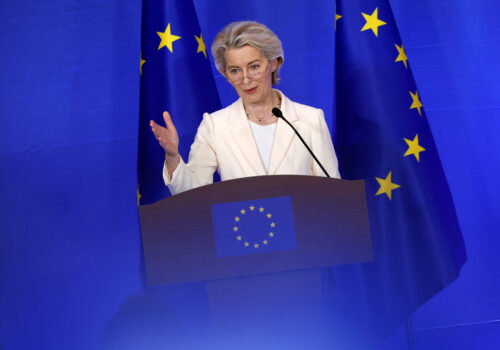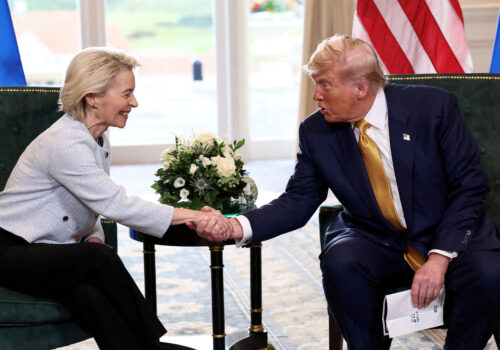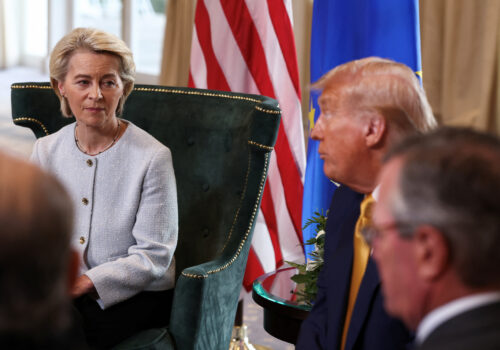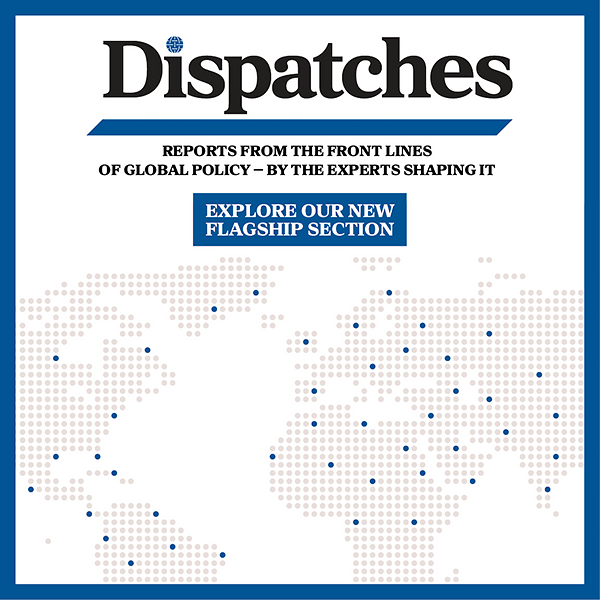The US-EU face-off over pharma is on pause—for now
After months of tough negotiations, the United States and the European Union (EU) settled on the fine print of a transatlantic trade deal on July 27. The deal locks in US tariffs on EU imports, with exceptions, at 15 percent, including on pharmaceuticals—a critical market for the twenty-seven-member bloc. European pharmaceuticals are also exempt from additional Section 232 tariffs, which the Trump administration is preparing for other trade partners. Given that US President Donald Trump had threatened tariffs on the industry as high as 250 percent at the start of this month, this locked-in lower rate is welcome news for many.
Of course, there are still downsides for the EU. With the 15 percent tariff rate, the EU’s pharmaceutical industry faces an estimated additional cost of up to $19 billion per year. In 2024, the EU exported nearly €120 billion in pharmaceuticals to the United States, representing 38.2 percent of all pharma exports outside of the bloc. It was the largest category of products by value exported to the United States by a significant margin. To say that a tariff rate soaring to 250 percent would have been devastating to the European pharmaceutical industry, and economy more broadly, is an understatement.
Regardless, the tariffs will still have an impact on both European firms and US consumers. To offset costs, many European pharmaceutical companies began to stockpile products in the United States, and some are beginning to announce new or upgraded manufacturing facilities in the country. This may have a negative impact on their overall footprint in Europe, though it is unclear how dramatic it will be. The deal will likely still raise prices for many Americans, as pharma companies pass additional costs onto consumers. However, the extent to which prices will rise is dependent on several factors, such as where the active pharmaceutical ingredient (API) is manufactured and whether the product is a brand name or generic drug.
Further complicating matters is a sticky situation in which companies have booked their patents in Ireland, for example, to avoid higher tax rates in other countries, though production can take place elsewhere. Should companies choose to shift these profits to the United States, they risk facing higher tax rates.
Finding a long-term, sustainable solution to ‘friendshoring’ pharmaceutical production benefits both the United States and Europe.
Tariffs may be the issue of the day, but they may not be the pièce de résistance impacting drug pricing in the United States or pharma companies’ relationships with Washington. According to a 2024 report, US customers pay nearly three times as much as consumers in other high-income countries for the same medications, a figure that has drawn Trump’s ire. To address this imbalance, the Trump administration is pushing for “Most Favored Nation” pricing on pharmaceutical products, which ties US prices to those in comparable countries. Unsurprisingly, Europe has been front and center in this debate as it exercises its regulatory might to ensure more reasonable prices while those in the United States continue to pay more due to confusing policies and systems, leading to claims of European free riding by US officials.
Already, some companies have begun to respond to US demands to adjust prices. Eli Lilly, which produces a leading diabetes medication, has said it will raise prices in Europe, presumably with the end goal of lowering them in the United States. Europe’s regulators will have to confront these and similar practices in the European market.
Between these tariffs and aggressive US drug pricing measures, transatlantic cooperation on any pharmaceutical or health policies will be difficult. However, both Europe and the United States stand to benefit from working together to accomplish an underlying goal the Trump administration is, perhaps unknowingly, targeting: securing affordable, accessible pharmaceutical supply chains.
When considering API sources, more than 60 percent of key inputs come from India and China, representing a significant risk for both US and European pharma companies should they lose access to these ingredients. Finding a long-term, sustainable solution to “friendshoring” pharmaceutical production benefits both the United States and Europe from a health and economic security perspective, as they both must mitigate the risk posed by foreign dominance in certain pharmaceuticals.
While Europe avoided the worst-case scenario through the US-EU trade deal, a 15 percent tariff on European pharmaceuticals benefits neither the United States nor the EU in the long term, weakening the transatlantic community’s interest in jointly addressing its common concerns abroad in favor of scoring political points.
Emma Nix is an assistant director with the Atlantic Council’s Europe Center.
Further reading
Fri, Aug 15, 2025
Talking past each other: Why the US-EU dispute over ‘free speech’ is set to escalate
New Atlanticist By Kenneth Propp
Republican-led US lawmakers and the White House are likely just getting started in critiquing the European Union’s Digital Services Act.
Mon, Jul 28, 2025
Trump and von der Leyen made a deal. But the US and EU are drifting apart on trade.
New Atlanticist By Frances Burwell
Many elements of the Turnberry deal still need to be finalized, and the difficult process could drive the two sides even further apart.
Sun, Jul 27, 2025
How big a deal is the new US-EU trade announcement?
Fast Thinking By
Our experts unpack the framework for a trade deal announced by US President Donald Trump and European Commission President Ursula von der Leyen on Sunday in Scotland.
Image: A visit is organized to pharmaceutical distributor Febelco in Frameries on Tuesday 04 March 2025. Febelco is the leading wholesaler-distributor in pharmaceutical distribution in Belgium with a 42 percent market share. Photo by Virginie Lefour. Belga via Reuters Connect.



